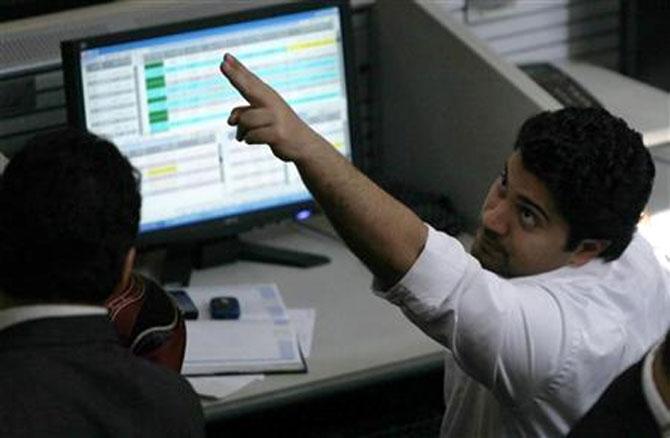Indian markets have crumbled in opening trade day after Wall Street's worst crash in six years. We reproduce a past article in which financial planner K Ramalingam lists the mistakes that can prove dear.

The current stock market crash accompanied by a climate of pessimism across the world calls for not just shrewdness while investing money in the stock market, but also for avoiding some common blunders that I find most long term investors make during a stock market fall.
It is true that your precious savings needs to be protected. And to grow, that makes me quote Ayn Rand, 'Wealth is the product of man's capacity to think'.
So let us think and avoid those five common blunders.
1. Being influenced by short term stock market losses
I have always advised young investors investing for long term capital gains to not panic if the value of their stocks erodes rapidly in just a year. It is not advisable to sell them to avoid further dips.
A strong unchangeable fact about the stock market is that it is subject to ups and downs.
The price of the stocks would rise all of a sudden, and selling would only make it difficult to recoup your portfolio to meet your long term financial goals.
The stock market is like a voting machine in the short run and weighing machine in the long run, hence long term capital creation requires buying stocks in an advantageous stock market.
2. Short selling to make profits
Short selling stocks at a higher price in the hopes to buying them back at a lower price proved risky for many investors.
They all have soon realised that it was always better to have a cotton shirt on their back rather than aspire and fail in getting a silk shirt and have no shirt at all.
People believe that investment experts and large stock broking houses will be able to predict the market.
If we watch and follow them we will be able to make quick bucks in short selling and F&O trading. Is that so?
Most of the big names in the stock broking sector were opening additional new branches in the upcountry side during the second half of 2007 (when the market was moving closer to 20,000 levels), expecting the market to go up further and hence their businesses will grow. But within six months, markets across the world had collapsed.
In the second half of 2008 these companies decided to wind up their newer branches in the upcountry as they were expecting further downside. But again within next six months market started their recovery.
Never enter into shorting deals during a stock market fall, but to hold on and invest more if you can make good returns in future.
3. Buying penny stocks of unknown companies in place of stocks of reputed companies
Market has fallen. You can invest now. Many investors fall prey for the idea of investing in penny stocks.
You may think that you will get more number of stocks when you buy penny stocks. Because you will get a very few stocks for the same amount if you choose to invest in large or midcap companies.
It is universal fact that investing in thriving longstanding companies rather than a lesser known company would guarantee you a good return in the long run. You should avoid investing a large sum in unknown penny stocks.
It is always advisable to take calculated risks and not blind risks.
By investing in a penny stock you are taking a blind risk which all successful investors avoid consciously.
4. Waiting for stocks prices to fall further before buying
When the market falls, that is a perfect time to start investing. Don't wait for the markets to bottom out. It is difficult to identify the bottom and invest. By the time you recognise the bottom, the market could have bounced back.
Stock market commentaries in the media always confuse us.
When the market was at 20,000 levels during December 2007, everyone in the media was predicting and analysing the possibility of the market reaching 30,000 levels. But markets crashed subsequently.
When they came down to 8,600 during November 2008, everyone in the media was predicting and analysing the possibility of market going down further to 3,000 levels. But markets bounced back.
The prudent and smart investors understood this and started investing when the markets started falling. They have staggered their investments over a period of time. They followed simple strategies like systematic investment plan and systematic transfer plan.
5. I want high returns but cannot see my capital fluctuating
Some young and middle aged investors invest in high return portfolios with a lot of midcap exposure, and realise that their portfolios have fallen 15 to 20 per cent with a stock market fall in just 3 to 4 months.
Their panic and decision to sell their stocks for reinvesting the same in fixed return investments like bank deposits or company deposits is wrong, and I would have advised them to just wait.
Their present loss and reinvesting in fixed deposits would take them longer to recoup the capital and make sizeable returns.
The solution lies in sticking on to the stock portfolio and be intelligent to buy more stocks for long term wealth creation.
The final word:
My final word of advice for long term investors is to never allow emotions or short term fluctuations to alter their investment decision, and to always buy in a falling stock market. I am sure a rational decision accompanied by safe dealings can make your long term financial goals a reality.
Lead image used for representational purposes only. Image: Mohamed Abd El-Ghany/Reuters
The author is Ramalingam K, an MBA (Finance) and certified financial planner. He is the founder and director of Holistic Investment Planners (www.holisticinvestment.in) a firm that offers financial planning and wealth management solutions. He can be reached at ramalingam@holisticinvestment.in.










